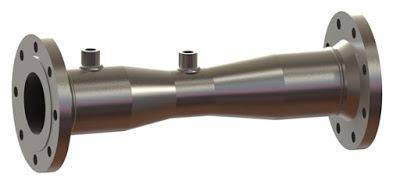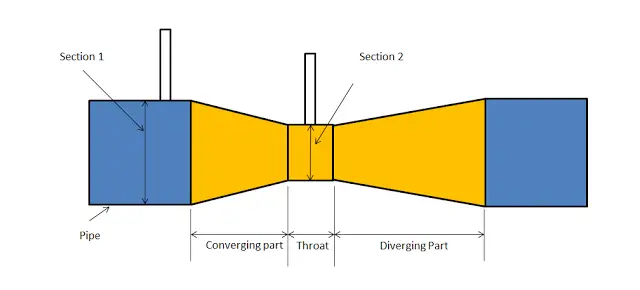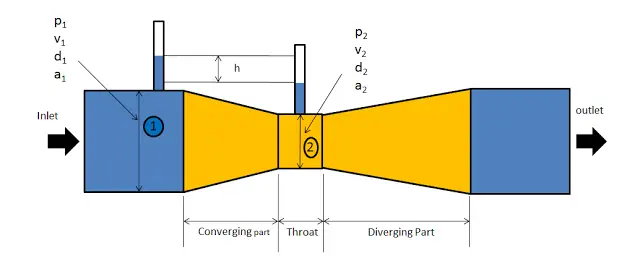What is Venturimeter?
A venturimeter is a device used for measuring the rate of flow of a fluid flowing through a pipe.
Main parts of Venturimeter
The main parts of a venturimeter are:
- A short converging part: It is that portion of the venturi where the fluid gets converges.
- Throat: It is the portion that lies in between the converging and diverging part of the venturi. The cross section of the throat is much less than the cross section of the converging and diverging parts. As the fluid enters in the throat, its velocity increases and pressure decreases.
- Diverging part: It is the portion of the venturimeter (venturi) where the fluid gets diverges.
Principle of Venturimeter
The working of venturimeter is based on the principle of Bernoulli’s equation.
Bernoulli’s Statement: It states that in a steady, ideal flow of an incompressible fluid, the total energy at any point of the fluid is constant. The total energy consists of pressure energy, kinetic energy and potential energy or datum energy.
Mathematically
Here all the energies are taken per unit weight of the fluid.
The Bernoulli’s equation for the fluid passing through the section 1 and 2 are given by
Construction
The construction of venturimeter is shown below:
It has three main parts
- Short converging part: It is a tapered portion whose radius decreases as we move forward.
- Throat: It is middle portion of the venturi. Here the velocity of the fluid increases and pressure decreases. It possesses the least cross section area.
- Diverging part: In this portion the fluid diverges.
Working
The venturimeter is used to measure the rate of flow of a fluid flowing through the pipes. Lets understand how it does this measurement step by step.
- Here we have considered two cross section, first at the inlet and the second one is at the throat. The difference in the pressure heads of these two sections is used to calculate the rate of flow through venturimeter.
- As the water enters at the inlet section i.e. in the converging part it converges and reaches to the throat.
- The throat has the uniform cross section area and least cross section area in the venturimeter. As the water enters in the throat its velocity gets increases and due to increase in the velocity the pressure drops to the minimum.
- Now there is a pressure difference of the fluid at the two sections. At the section 1(i.e. at the inlet) the pressure of the fluid is maximum and the velocity is minimum. And at the section 2 (at the throat) the velocity of the fluid is maximum and the pressure is minimum.
- The pressure difference at the two section can be seen in the manometer attached at both the section.
- This pressure difference is used to calculate the rate flow of a fluid flowing through a pipe.
Also Read:
Centrifugal Pump – Working Principle, Main Parts with Application
Positive Displacement Pump – Definition, Types, Working
What is Cavitation and How it Occurs?
Expression for the rate of flow through Venturimeter
Considered a venturimeter is fitted to a horizontal pipe through which fluid ( water) is flowing as shown in the figure given below.
Let d1, p1, v1 & a1, are the diameter at the inlet, pressure at the inlet, velocity at the inlet and area at the cross section 1.
And d2, p2, v2 and a2 are the corresponding values at section 2.
Applying bernoulli’s equation at sections 1 and 2
As the pipe is horizontal, so z1 = z2
Therefore
(P1 – P2)/ρg is the difference of pressure heads at section 1 and 2 and it is equal to h. so
Substituting this value of h in equation (1), we get
Now applying continuity equation at section 1 and 2
Substituting this value of v1 in equation (2) and solving, we get
Discharge
Substituting value of v2 in above equation
Q is the theoretical discharge under ideal conditions. Actual discharge will be less than the theoretical discharge. The actual discharge is given by the formula
Where Cd is the coefficient of venturimeter and its value is less than 1.















